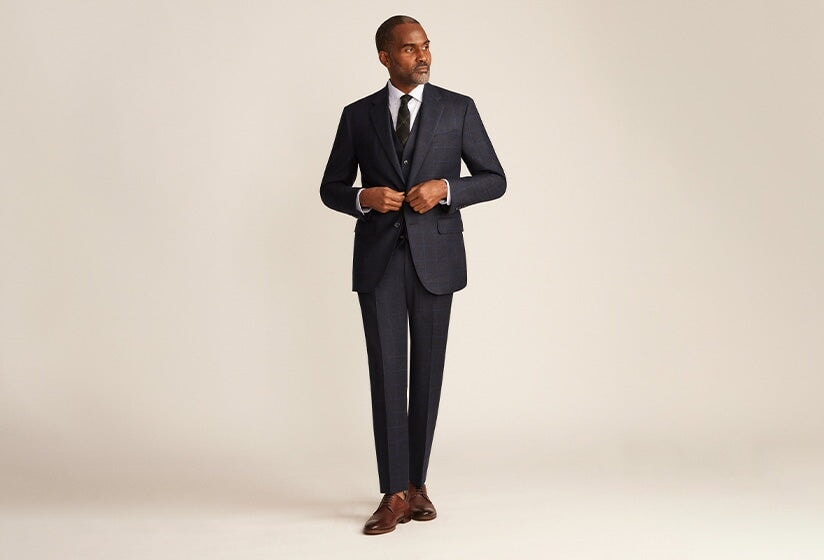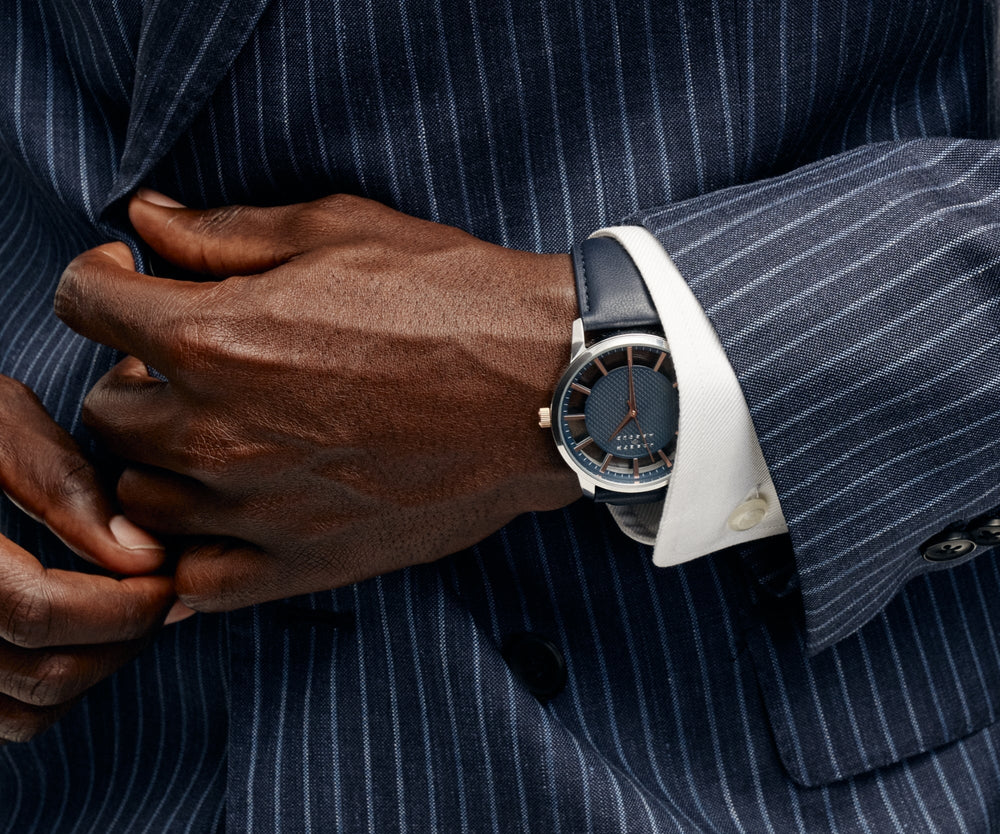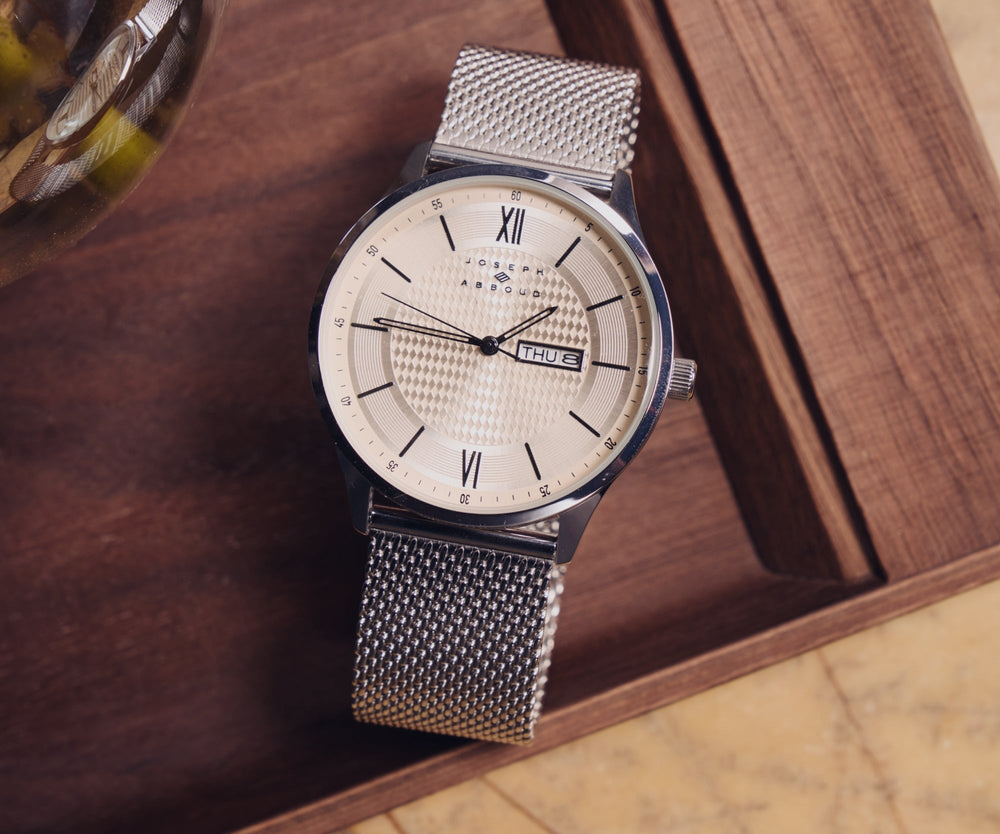How Should a Men’s Suit Fit? Our Top Tips for a Perfect Fit
- by Off The Cuff
- |
- September 21, 2022
- |
- 5 min read
You’ve got your favorite watch and all of your best suit accessories. You’re officially ready to tackle your day (and turn some heads in the process) once you pick the right suit.
Nothing builds confidence for men quite like tailored men’s suits. Interestingly enough, the greatness of a suit doesn’t always rely on choosing the most expensive fabric or the trendiest style. Looking great in a suit always starts with the fit—no matter what suit you wear.
If you’re not completely in the know, you might be asking yourself:
“How should a men’s suit fit?”
We’ve got you covered. Here’s our ultimate guide on how a suit should fit, from the collar of your suit to the break.
The Jacket Collar
The collar is often the most ignored of all areas when it comes to men’s suits. However, any well-dressed man knows that a suit jacket collar needs to fit them properly for them to look their best.
A well-fitted suit jacket collar should gently rest against the back of your shirt collar, with both collars lightly resting on the back of your neck. They should be lightly touching each other with minimal gaps between each layer, giving the back of your neck a natural look.
How it shouldn’t fit: A collar that is too loose will be obvious—you’ll see a significant gap between the suit collar and the back of your neck. A collar that is too tight will instead create an unwanted bunching effect that takes away from the clean-cut look of your suit.

The Shoulders
We know that alterations can always be made on suits. However, some parts of a suit are much more difficult to alter than others.
Case in point: the shoulders. It’s crucial to get the shoulder fit right the first time, so choosing a made-to-measure or bespoke suit option is king here.
The shoulder of your suit jacket should lay flat to your shoulder, with the seam lining up directly on top of your shoulder bone. The shoulder of the suit and the arm of the suit should meet up exactly where your actual shoulder and arm meet.
How it shouldn’t fit: If the shoulder is too big for you, you’ll notice that the seam lines up more down the front part of your shoulder or your arm. It also won’t lay flat against your shoulder. If it’s too small, the opposite will happen—the seam will come up closer to your neck.
Regardless of whether the shoulder is too loose or too tight, it will cause the rest of the suit to sit improperly.
Jacket Closure
A crucial part of the fit rules governing men’s suits is how a suit feels once it’s buttoned. Although most of us know the rules of buttoning a suit (button the top, leave the bottom unbuttoned), how the suit fits once it’s buttoned isn’t always clear.
When you put on the jacket and fasten the button, you want to be gently held in. The jacket should lightly hug your body from the shoulders all the way down to the bottom of the suit. It should fasten without any strain, and the fabric shouldn’t wrinkle anywhere.
It’s normal to see a little bit of your shirt while moving, but generally, a well-fitted suit jacket closure should cover most of your shirt near your belt line.
How it shouldn’t fit: Avoid the dreaded “X” at all costs. When a suit jacket is too small, you’ll immediately notice an X-shaped crease begin to form from just below the lapel on both sides.
Conversely, a suit that is too large will flare out at the bottom, just like a pair of ’70s bell bottom pants. Either way, you end up with a suit jacket that won’t leave you feeling confident.

The Sleeves
The sleeves are one of the first parts of a suit that well-dressed men notice. In many cases, well-fitted suit sleeves end up being the difference between a man that is put together and one that looks like he grabbed his father’s suit from the closet in a hurry.
The classic rule for your jacket sleeves is for a half-inch of your shirt cuff to show beneath your sleeve. This is still applicable today, but you don’t need to obsess over the exact length—getting somewhere in that ballpark is fine and will still have you looking your best.
Another great guideline is to have your jacket sleeve break immediately above your wrist bone.
How it shouldn’t fit: Sleeves that are too long have you looking like you’re wearing a suit that doesn’t belong to you. When the sleeve covers your entire shirt cuff, you lose that clean and crisp look associated with a nice suit. On the other hand, sleeves that are too short will have far too much cuff showing.

Jacket Length
Another often-overlooked aspect of how a men’s suit should fit is the overall jacket length; it’s just as important as the rest of the suit!
The professional standard for suit jacket length ends up draping past the waist and landing somewhere near the middle of your thumb knuckle when your arms are resting at your sides. It’s not an exact science because body types are incredibly diverse, so anywhere within an inch of that area is okay.
This is considered a mid-length fit and is typically a safe choice when you want to avoid avant-garde looks.
How it shouldn’t fit: The hem of your jacket should never rest at the top of your buttocks. Conversely, it shouldn’t drape so far down that you enter white-tie territory.
In either case, you’ll want to be careful when choosing jacket length. You have an inch or two of play for alterations, but anything else will cause the front pocket flaps to look out of place.
The Seat
Your trousers play an essential role in your appearance as well. The seat should lay naturally across your buttocks with no visible creasing or folds. It should gently touch your underwear without any pulling or loose draping down the back of your thighs.
How it shouldn’t fit: Horizontal wrinkles begin to form on the seat when the trousers are too tight. If the seat is too loose, you’ll notice the fabric begins to create U-shaped, sagging folds on the back of your thighs.
When choosing your trouser fit, always choose slight looseness over tightness. It’s much easier to take in a seat than to let it out. However, be careful—don’t go too loose. There’s only so much that a tailor can do.
Trouser Length
Similar to sleeve length, trouser length will be one of the first things that a well-dressed man notices about another man in a suit.
The standard trouser break is when the trouser gently makes contact with the shoes. This type of fit will create a very subtle wrinkle at the front of the ankle. It’s also okay for the trouser to come down further in the back, as long as it rests above the heel of the shoe.
How it shouldn’t fit: Your socks shouldn’t be showing too much unless you sit down or want to make a dramatic statement with no break at all. Typically, if your socks are showing, your trousers are too short. When your trousers are too long, you’ll have an excess amount of material bunching up in the front.
Luckily, trouser length is one of the easiest things to alter. Dress pants are often sold with the intention that the wearer will make alterations to the length.
Discover Your Perfect Fit with Joseph Abboud
At Joseph Abboud, our mission has always been to help men look and feel confident. Our bespoke men’s suits achieve this by bringing concierge-level service to you, with suit styles tailored to your exact measurements. The result? A suit that is custom made—by you, for you.
Achieving your ideal image has never been easier—or so refined. Discover more about how our bespoke suit experience can elevate your style.











